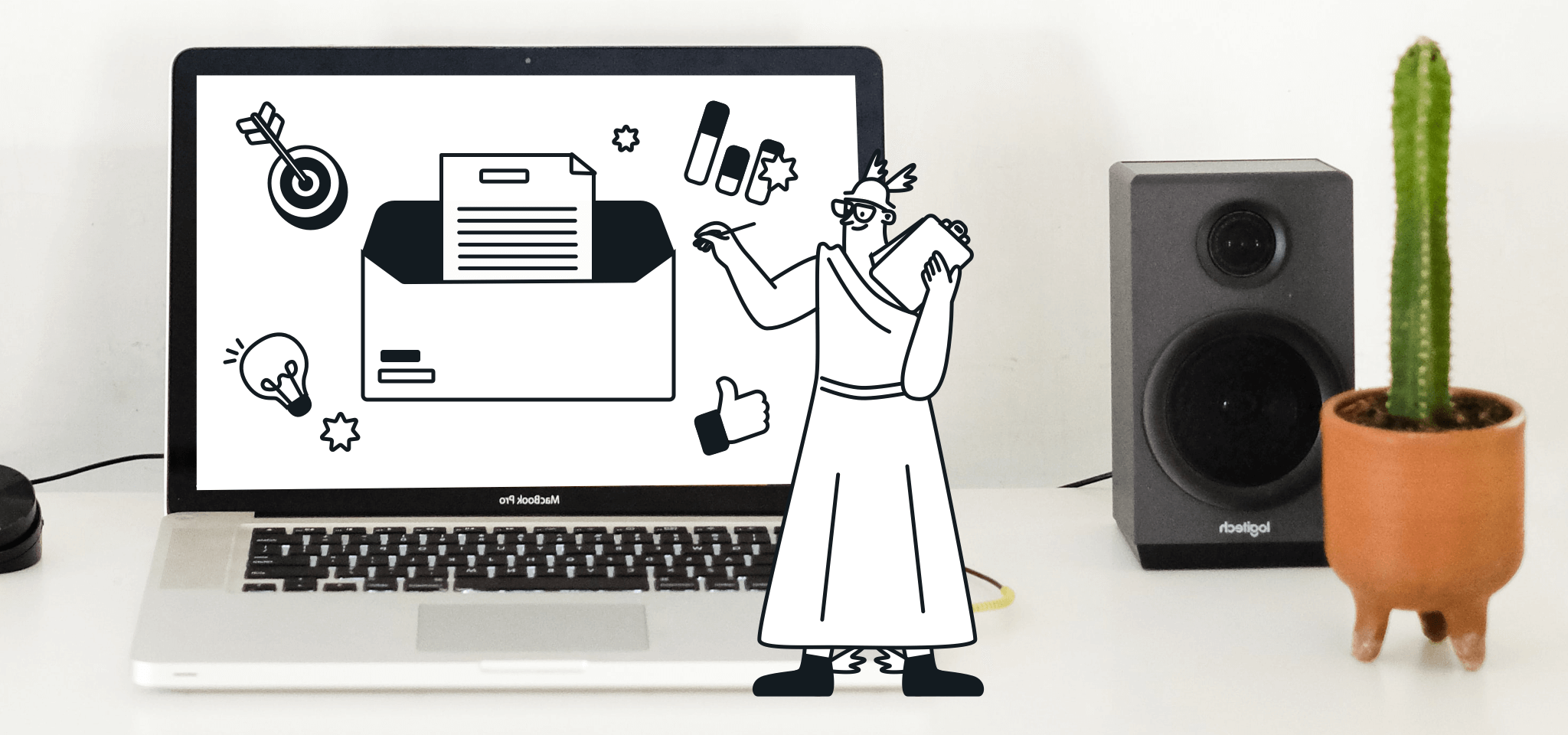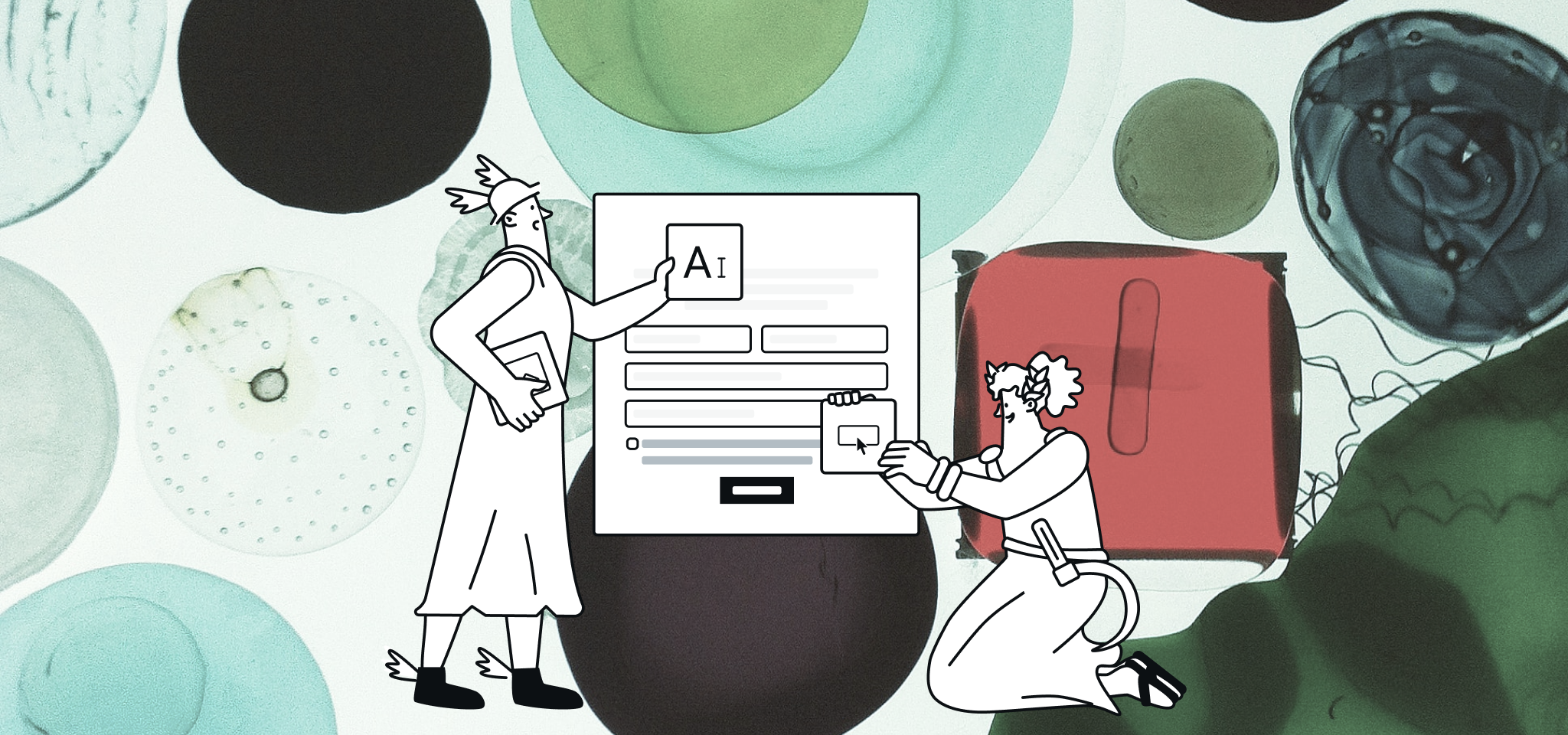Home
The Mailjet Blog
Email best practices
Win the Attention of Your Customers With Email Personalization
Email best practices
Captivating customer attention with email personalization
Amidst the sea of endless information, capturing a customer's attention is a challenge for marketers. But with the magic of personalization, Kelly Schaefer-Flake shows us how to make customers feel special.
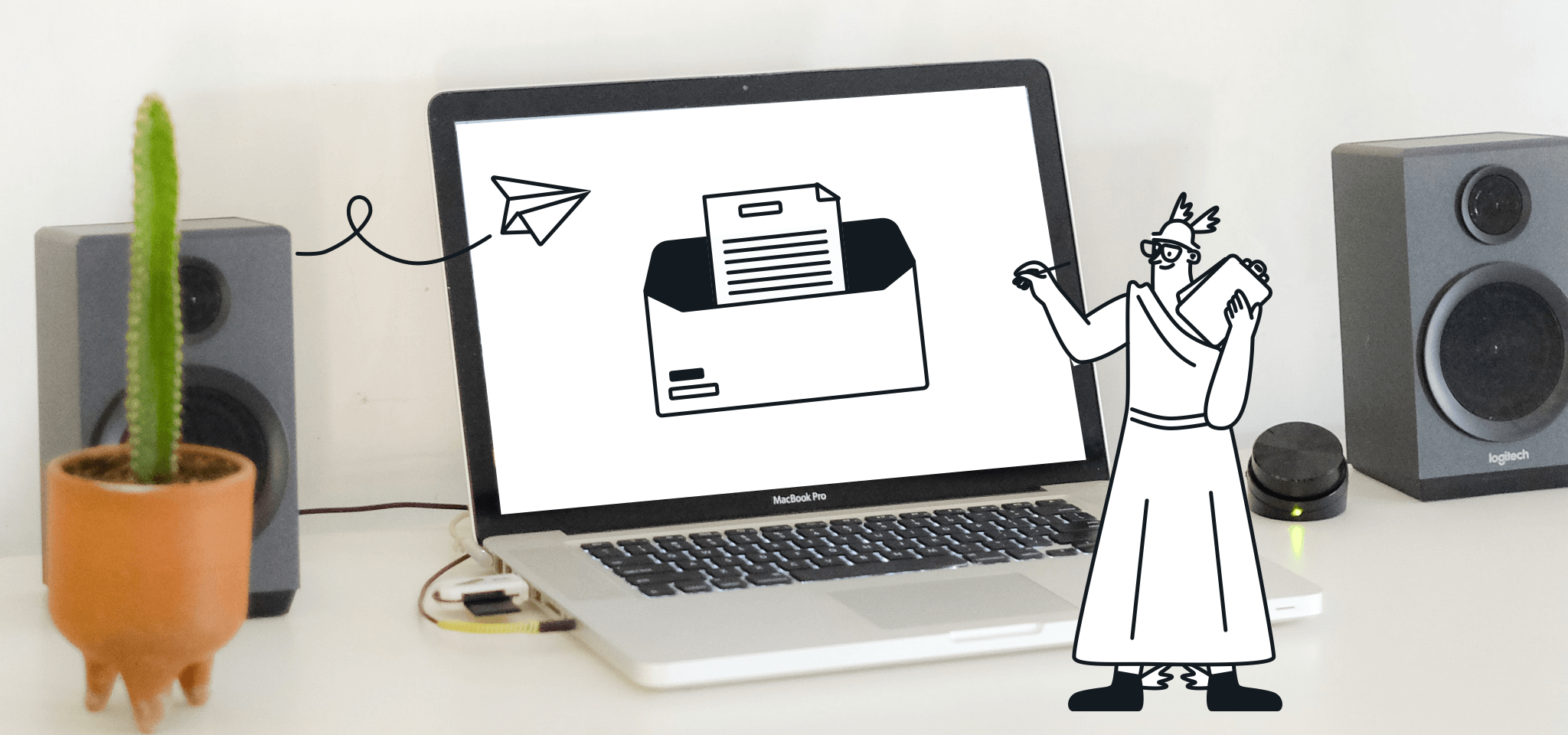
PUBLISHED ON
You know how it is – we're all constantly bombarded with information. Therefore, the attention economy has become ultra-competitive, making a marketer's job of capturing and engaging customers more challenging than ever.
That's why we were grateful to have Kelly Schaefer-Flake, Sr. Manager, Solutions Consulting at Iterable speak at Mailjet’s Email Camp 2022 to shine a light on email personalization. She showed us how to win over our customers' hearts and minds to keep them engaged.
We'll take you through the changing landscape of how people are browsing and consuming information, break down Kelly’s three-step process for personalization, and share some of her favorite examples.
Table of contents
The challenges of personalization
Apple’s “trillion dollar” email
Level one: The basics
Level two: Personal recommendations
Level three: Individualization
Profiling the user: Outdoor enthusiast
The onboarding experience
Personalized engagement
The recap email
What is personalized marketing?
For too long, we’ve marketed to the masses. The Don Drapers of yesteryear would pitch delightful ad ideas to companies targeting the bulk of middle-class America.
But things were different back then. Nowadays, everyone deserves to feel unique, with their own wants and needs addressed.
Personalized marketing breaks traditional conventions by leveraging data to deliver targeted messages at scale. It could be something as simple as using a person’s name in the body of a message or as complex as delivering oddly relevant dinner recommendations in a timely fashion.
Some examples of personalization in marketing include:
Targeted email campaigns
Recommendation engines
Personalized ads
Personalized landing pages
AI chatbots
You’ve probably seen the hugely popular Spotify’s Wrapped or Netflix’s email recommendations. These companies have utilized user activity data to serve users valuable content that really resonates with them. Not only does this boost engagement rates now, but customers are more likely to eagerly await these brands’ campaigns in the future.
Sound like a lot of work? Our speaker Kelly revealed why this form of marketing is becoming increasingly important.
“Moving forward, we have to know, as marketers, that personalized experiences are essentially making or breaking a customer's loyalty to your brand. And that's absolutely going to extend through our email strategy as well.”
Kelly Schaefer-Flake, Sr. Manager, Solutions Consulting at Iterable
The challenges of personalization
Here’s a stark warning for marketers and something we’ve suspected for a while now – attention spans are dwindling.
These are the estimated attention span over the years:
2000: 12 seconds
2010: 8 seconds
2022: 5 seconds
2030: We don’t want to know
So, it’s a fact that customer attention is finite, and you already know your competitors are competing for their share of the cake. But all is not lost – customers are also telling us they want tailored communications from the brands they love.

Data shows that consumers really value a great user experience when they're shopping. But it looks like not all brands are hitting the mark. In fact, only 60% of brands are offering them personalized experiences, so this could be a great opportunity to cut through the noise and deliver something consumers truly want.
“In its simplest form, what we're talking about here is a strategy whereby companies leverage data and technology to deliver individualized messages at scale.”
Kelly Schaefer-Flake, Sr. Manager, Solutions Consulting at Iterable
We know personalization is fundamentally easier said than done. Most marketers still default to basic personalization, like including a first name, and this type of personalization effort often falls short and ends up being more annoying than helpful. According to Kelly, 77% of consumers get frustrated by irrelevant emails, push notifications, or SMS messages, so providing a truly personalized experience is a must for brands that want to build strong relationships with their customers.
And not every brand is up for the challenge. In fact, a recent study predicts that, by 2025, 80% of marketers who try to personalize their efforts will give up due to either a lack of return on investment or difficulty managing data. And, let’s be honest, these two form a vicious circle: In many cases, the complexities of data management end up playing a big role in the lack of ROI generated by these efforts.
So, if you’re going to delve into the world of personalization, it’s important to have the time and resources.
Getting personalized email marketing right
To give customers the ultimate personalized experience, Kelly advocates for getting the mix of customer, message, timing, and message personalization just right. It's all about finding that sweet spot between these elements.
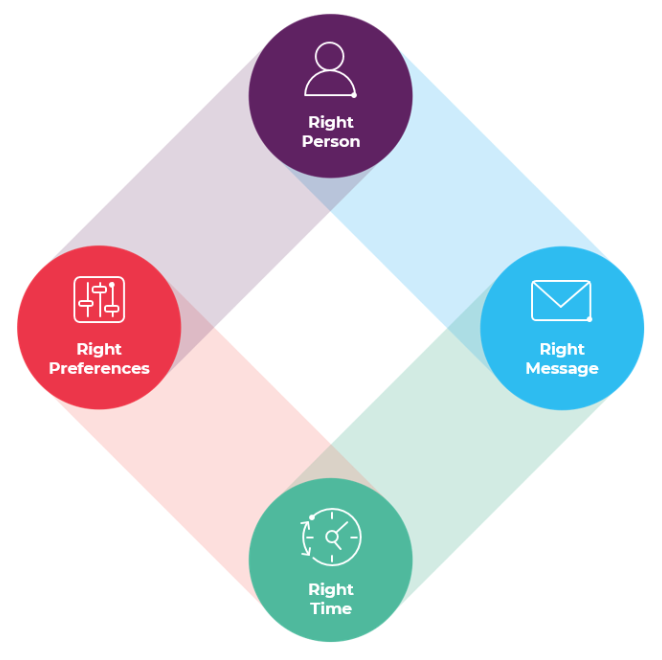
Getting all the right engagement factors aligned.
But how do you find that right balance? Well, the key is to start small and gradually build up to a fully-fledged personalized marketing strategy. According to Kelly, you can't expect to get it right on the first try, but by making small changes and fine-tuning along the way, you'll start to see progress.
It's also important to remember that there isn't a single, universal solution that works for everyone. Personalization is all about tailoring an experience to the individual, so each customer might need a different approach.
“One thing that I really want to focus on here is that it's important to make incremental changes with personalization. Changes that will eventually scale into an effective, individualized marketing strategy.”
Kelly Schaefer-Flake, Sr. Manager, Solutions Consulting at Iterable
Apple’s “trillion dollar” email
Sometimes great personalization is all about understanding the context and offering customers what they need, just when they need it.
During the pandemic, Apple found a way to surprise customers who ordered a new laptop by sending them an email exactly 20 minutes after delivery. The email offered them the chance to “Explore your Mac with a specialist online.”
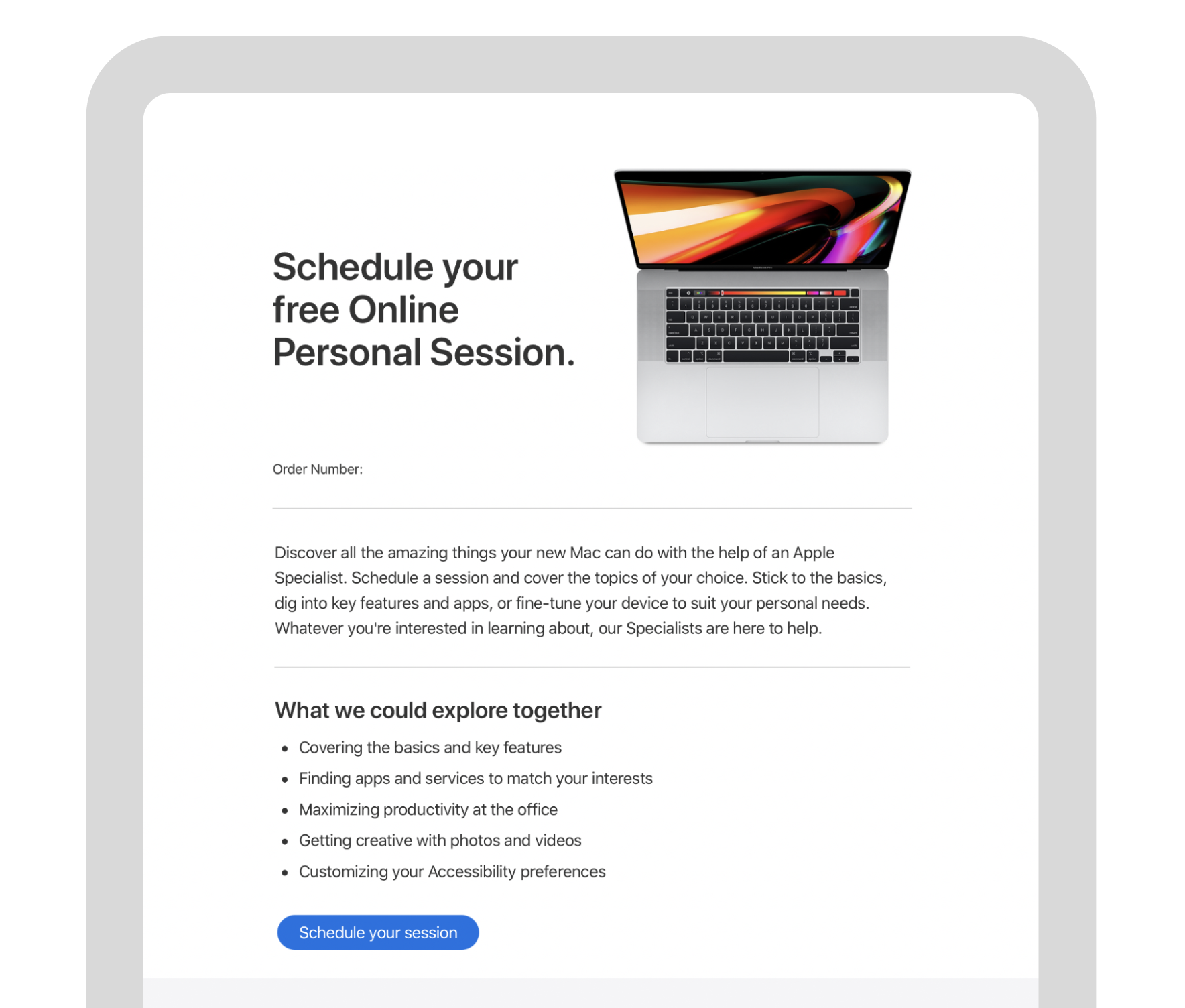
During her session, Kelly explained how this campaign hit all the cornerstones of good personalization:
Right person: A new Apple MacBook Air user
Right message: “Explore your Mac with a specialist online” message
Right time: 20 minutes after FedEx delivery
Right preferences: A personal email touch, even while social distancing
Apple knows their customers are most excited right after receiving their new product. Getting them brushed up on new features means their product is fully utilized and better appreciated. And even if the customer chooses not to talk to a specialist, they still feel supported.
“It's an example of how a simple yet thoughtful email transformed a really mundane chore of a new computer set up into a powerful moment of personalized brand ubiquity.”
Kelly Schaefer-Flake, Sr. Manager, Solutions Consulting at Iterable
A three-tiered personalization strategy
When we think about email personalization, we often think about a first name, a dynamic product recommendation, or maybe even Apple’s email. But as Kelly eloquently reminded us during her Email Camp session, personalization is a strategy, not just a one-off tactic. And that’s something senders often forget about. In fact, only 40% of marketers actually have a clear personalization strategy, according to Gartner.
So how do you build an email personalization strategy? Kelly’s advice is to start small and gradually build up to more complex personalization at scale. Basically, make sure you don’t run before you walk. That way, you can see what works and what doesn't, and make adjustments along the way.
To help you build your email personalization strategy from the ground up, Kelly proposes this's “holistic cross-channel experience” strategy, with three levels of progression – from the basics right through to advanced personalization.
Level one: The basics
To get started, it's important to define a campaign and make small improvements over time. For example, you can start with reactive campaigns that use profile attribute data like names, birthdays, or city. These could include things like sending birthday emails, segmenting by list preferences, or sending cart abandonment messages.
Just by adding a name to an email subject line alone, you can increase the probability of an open by 20%, boost sales leads by 31%, and reduce subscription rates by 17%, according to a study at Stanford Graduate School of Business.
One simple way to gather information from customers is by building signup forms that allow you to collect relevant user data, like the ones offered by Sinch Mailjet. Start with the basic information and then ask additional questions like location, birthday, and occupation. This level one tactic can boost campaigns that drive higher conversions, such as sending personalized offers or back-in-stock campaigns based on a customer's purchase history.
As you get more comfortable with personalization, you can start tailoring your messages to be even more personalized. This could include things like recommended products based on browsing history or location-based messaging. Remember our new motto: Personalization doesn’t have to be scary if you start small and build upon your successes over time.
Level two: Personal recommendations
The second level of personalization is when you go from being reactive to being proactive. Imagine being able to use a customer's past behaviors to make predictions about what they might do next.
As you advance your personalization efforts, you can start tailoring your messages to be even more personalized. You can go from segment-based messages to one-on-one messaging that really speaks to the recipient, like sending a recommendation for a new Mediterranean restaurant to nearby customers that have previously interacted with similar takeout spots.
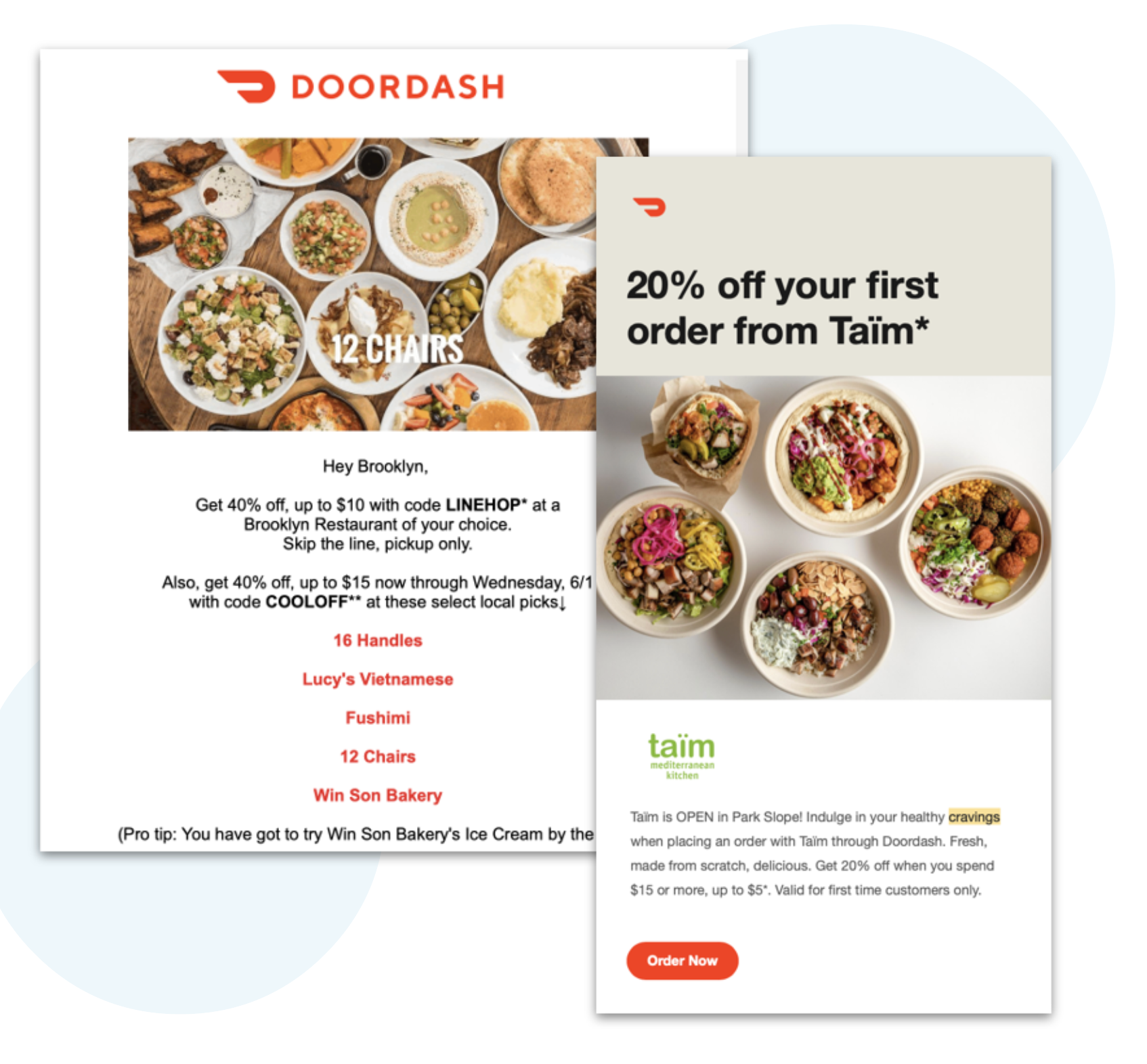
Some advanced email personalization strategies include:
Personalizing based on website activity
Geofencing or location tracking
Using behavioral events like downloading an app or completing a signup
Enriching your email messages with metadata
Cross-channel messaging based on the customer's experience
You’ll notice that at this level, we’ve moved away from blanket tactics and campaigns to a level of thoughtful planning. We’re now trying to nail down a person’s wants and needs in the context of their life – just like Apple did in that example from earlier.
Level three: Individualization
As you can expect, the third and final level is the most advanced and sophisticated of them all. It's all about treating each customer as a unique individual, going beyond just messaging to getting to know them on a deeper level. By this point, everything should be fully automated and in motion.
This level of personalization leverages those automation capabilities to offer value based on a customer's interests, wants, needs, and identity in real time. It requires a variety of data points like profile information, behavior, and position in the customer lifecycle. The result is highly personalized messages that even use the customer's brand affinity to make rich, tailored product recommendations.
The messaging in these campaigns includes dynamic content and even leverages predictive analytics to trigger real-time experiences. It’s all about providing the customer with an experience that is specifically tailored to them, making them feel seen and understood.
A good example of individualized email marketing is Duolingo. The popular language app collects data on every interaction a user makes and feeds it back to them as encouragement to consistently learn their language of choice.
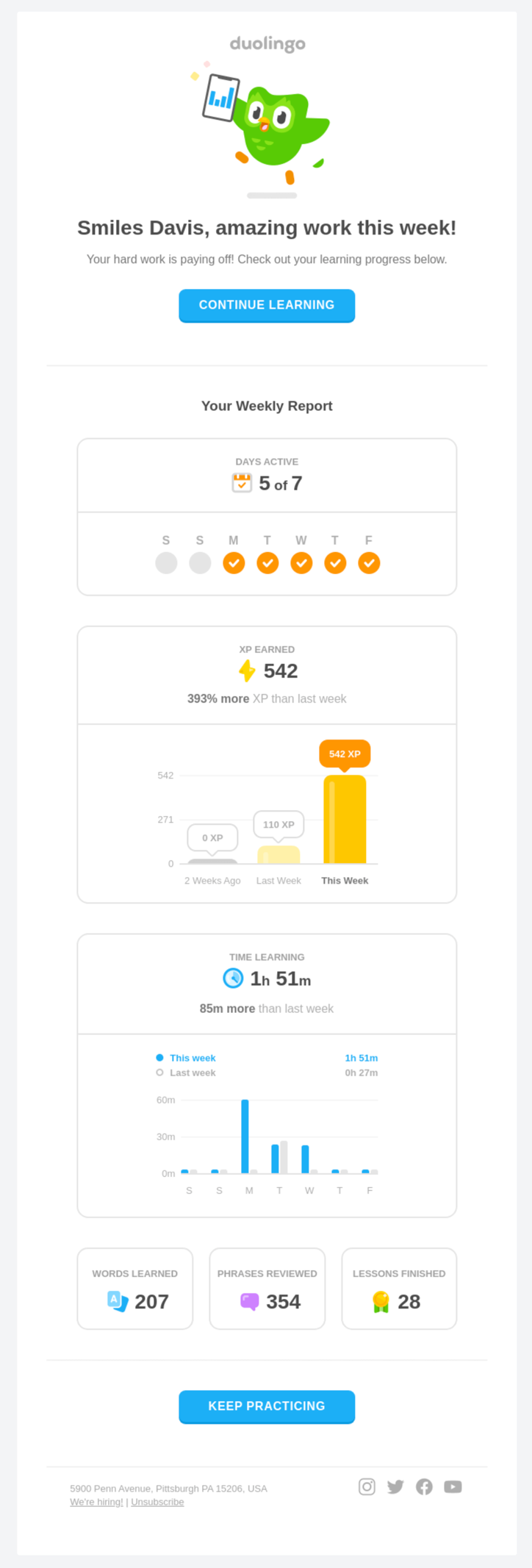
Level three email personalization at work from Duolingo.
Some of Duolingo’s helpful individualization includes:
A weekly summary of a user’s learning activity
Week-over-week activity comparisons
Daily reminders to log in and complete their lesson
An email prompting users to download or return to the app after a prolonged period of absence
But how do you choose what to focus on when you start building your individualized email experiences? Kelly recommends A/B testing different options to find what works for you.
“A/B testing is key here. So, you can run tests to see hey, ‘Does a default value have more of an impact than nothing?’ And again, it's going to vary for every brand.”
Kelly Schaefer-Flake, Sr. Manager, Solutions Consulting at Iterable
Now, we’ll see how all three tiers of personalization can play into a truly personal app experience worthy of sharing at Email Camp.
Email personalization in action: The fitness tracking app
Think about how many apps you’ve downloaded and then deleted. The difference between deleting and staying on the home screen is building a strong user experience (UX) that turns your platform from “any other app” to the app user can’t stay away from. And, of course, personalization plays a big role in this process.
Here’s how Stravia, a popular fitness tracking app, leveraged personalization to create a truly unique experience for Kelly.
Profiling the user: Outdoor enthusiast
Kelly’s passionate about outdoor activities such as biking, hiking, and trail running. So, she decided to download a social fitness app to track her progress and get better every week.
During the registration process, she provided basic demographic information, including name, location, and birthday. She also opted in to receive new challenges and monthly stats by email.
The onboarding experience
The fitness app has an effective onboarding process that made it easy for Kelly to get started. She completed a short survey about the activities she participates in the most, which personalizes the challenges she sees within the app and informs the marketing team of the content she’ll want to see.
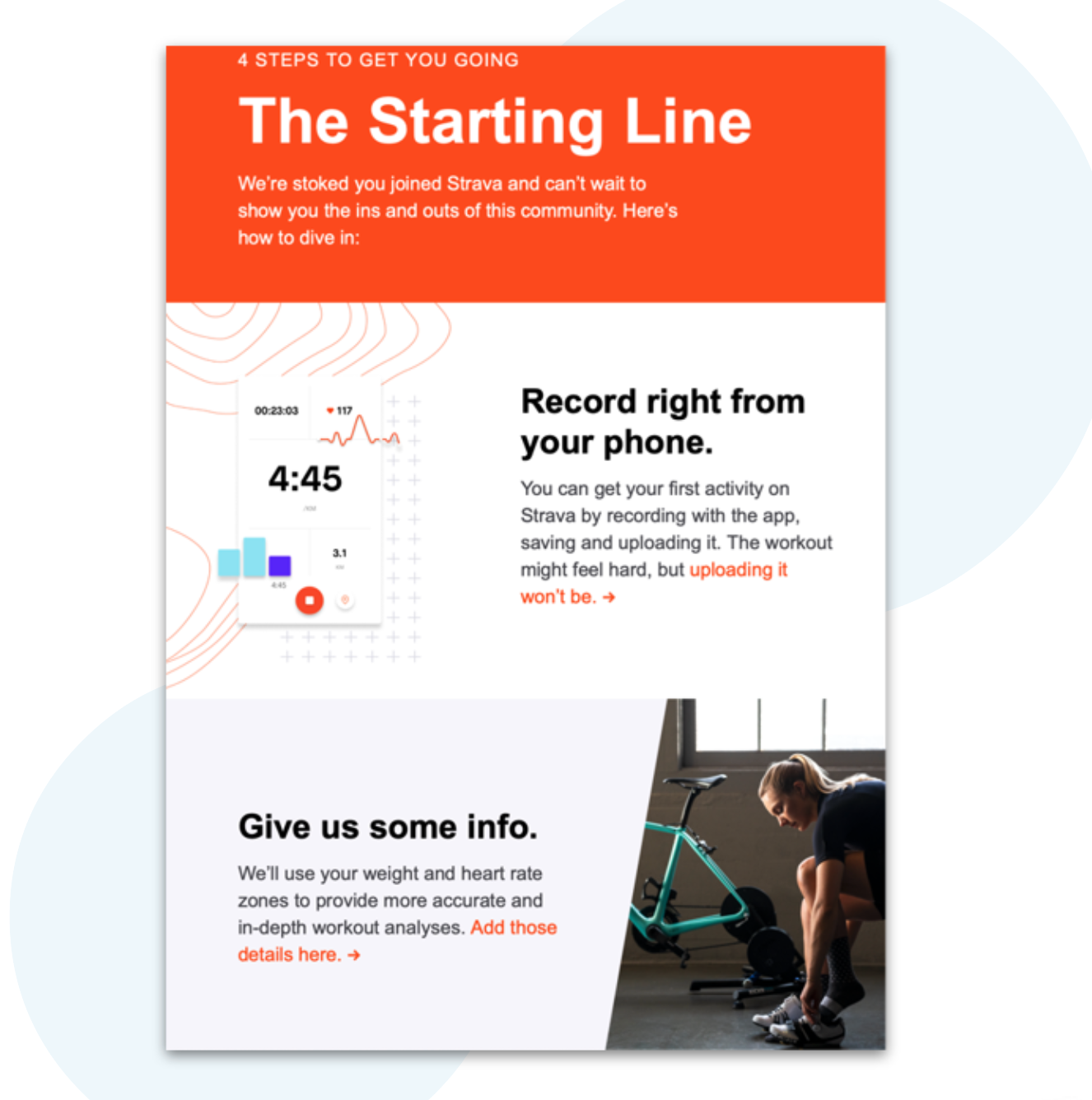
As part of the welcome series, Kelly received an email prompt to get started with her activities and provide more information, like weight and heart rate, to receive an accurate activity analysis.
Personalized engagement
Kelly engaged with the app regularly by recording her activities and opening its emails. The company identified that she was checking these messages on Saturday and Sunday mornings and then going for a hike in the afternoons.
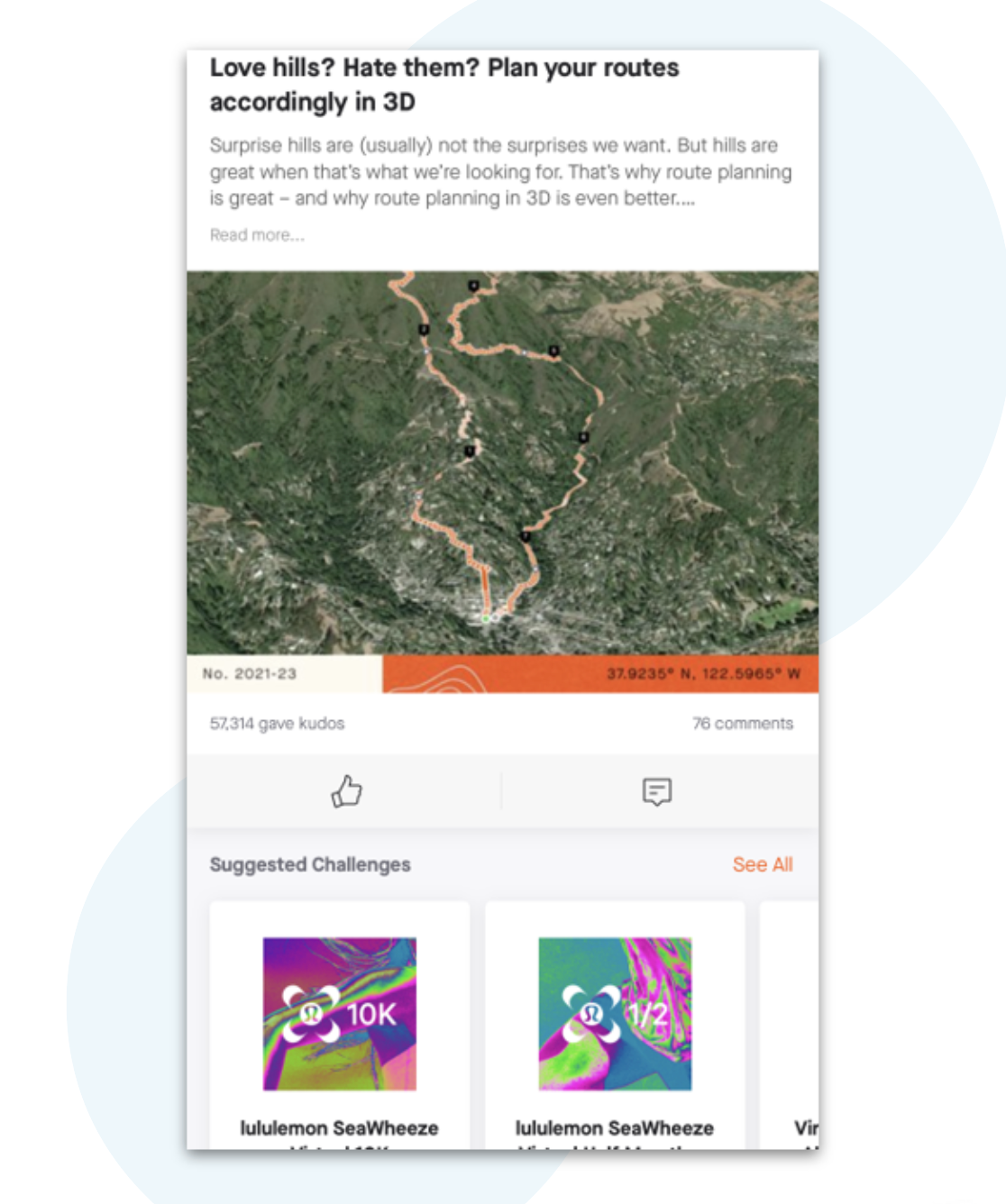
With this information, the fitness app sent her personalized content recommendations and suggested challenges for her weekend hikes. The suggested challenges were derived from other challenges she had done in the past, keeping her excited and engaged with the app.
The recap email
A month after initially downloading the app, Kelly received a personalized message on a Sunday morning with a recap of all her activity. The email included visual and numerical representations of total activity, personal records, and how she stacked up against other users.
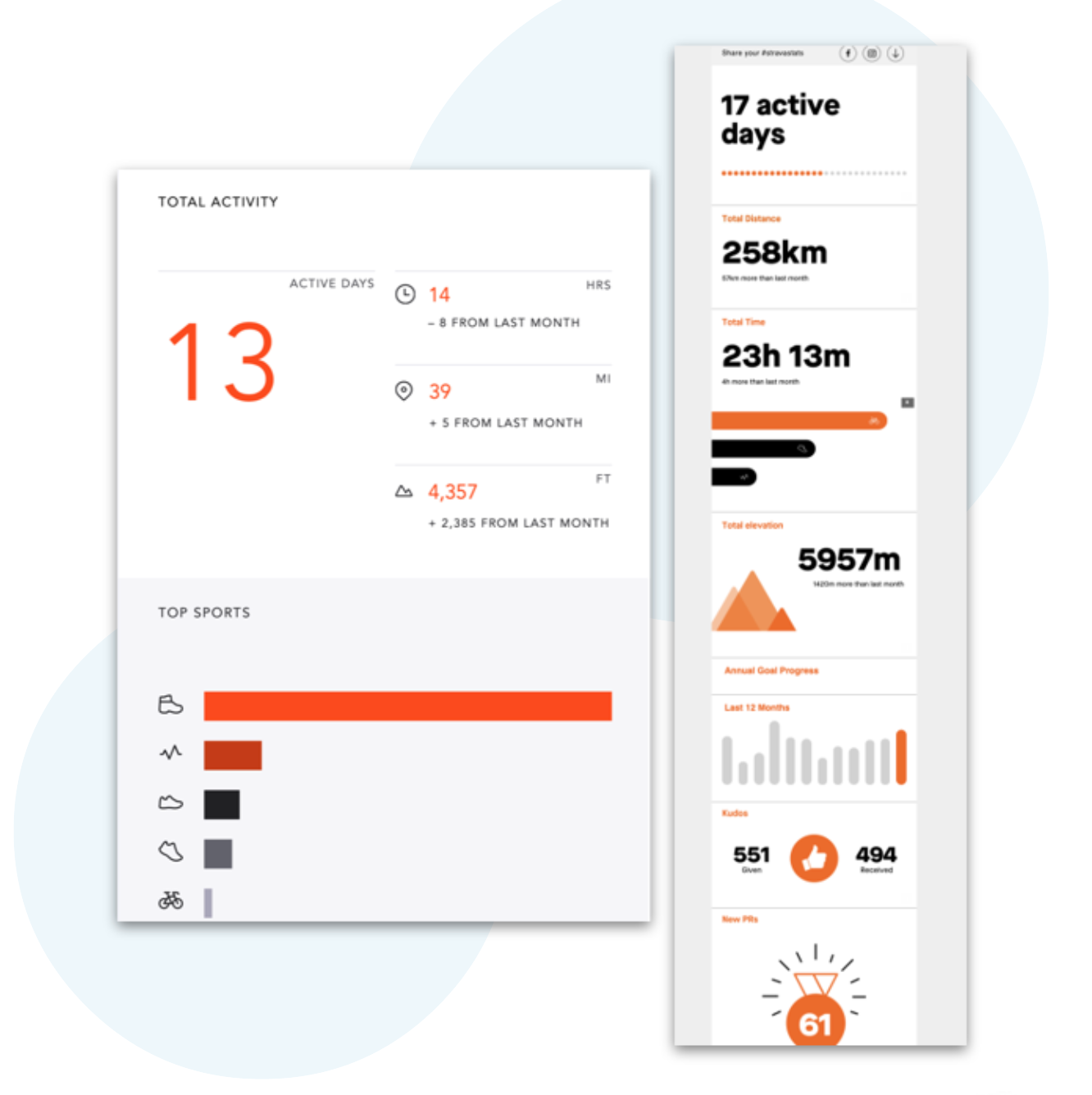
By leveraging Kelly’s data, the company was able to increase her engagement by 80%, regularly drive her back to the platform, and turn her into an advocate that shared the app with others.
Just by understanding a customer’s preferences and behaviors, this fitness app was able to send “the right message, to the right person, at the right time.”
Learn more about email personalization with Email Camp
Hopefully by now, you know just how much value there is in creating unique user experiences. By leveraging user data, you can create a personalization strategy that keeps customers coming back time and time again.
Watch Kelly Schaefer-Flake’s full session below: Painting The Billboards: Captivating Customer Attention With Email Personalization.
Kelly was one of many memorable speakers from Mailjet’s annual virtual email event, Email Camp. But she was definitely not our only speaker! Check out last year’s Email Camp 2022: Road Trip Edition and learn from all our thought leaders on our YouTube channel.
Want to make sure you don’t miss all the great sessions and content at Email Camp 2023? Register below!




